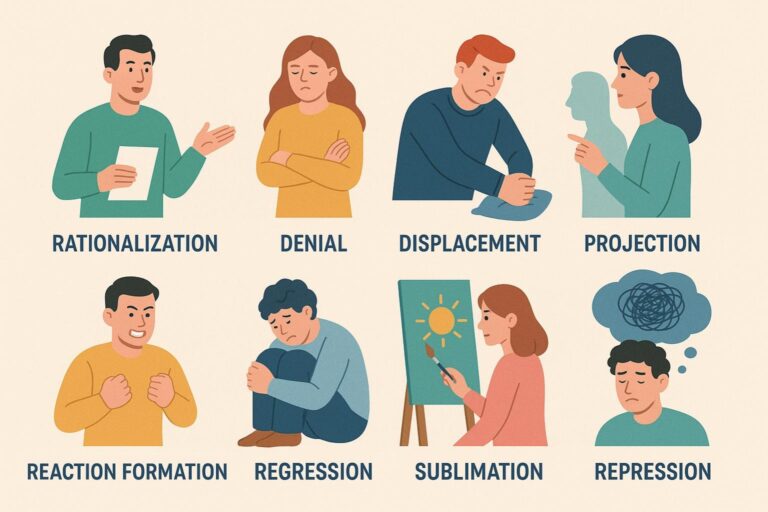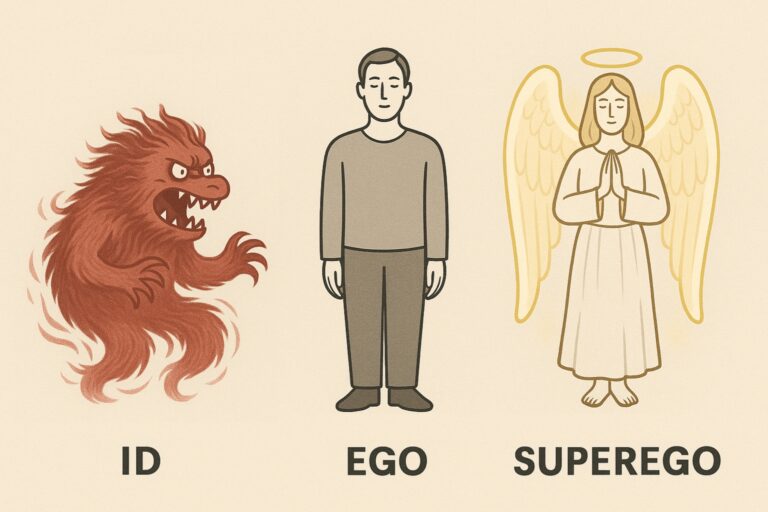Psychoanalysis: Freud’s Theory and Therapy Method Explained

Quick Summary
Psychoanalysis is Freud’s theory of how unconscious thoughts and early experiences shape behavior. It is also a therapeutic method that helps people explore repressed emotions, understand inner conflicts, and achieve long-term psychological growth. Key concepts include the id, ego, superego, defense mechanisms, and psychosexual development, which are applied in therapy through techniques such as free association, dream analysis, and interpretation to uncover hidden patterns and promote emotional insight.
What Is Psychoanalysis?
Psychoanalysis is both a psychological theory and a therapeutic approach developed by Sigmund Freud in the late 19th and early 20th centuries. It emphasizes how unconscious mental processes significantly influence thoughts, emotions, and behaviors, often shaped by early childhood experiences.[1] Psychoanalysis seeks to reveal and resolve unconscious conflicts through various techniques, enabling individuals to experience deep psychological change and improved emotional health.
This article explores psychoanalysis in three parts:
- Its theoretical foundations
- Its methods as a therapy
- How it has evolved over time
Psychoanalysis as a Theory of the Mind
1) The Unconscious Mind
Freud proposed that the mind operates on three levels:
- Conscious: Active thoughts and perceptions
- Preconscious: Accessible memories
- Unconscious: Repressed thoughts, emotions, and desires.[2]
According to Freud, the unconscious significantly influences behavior, often manifesting through dreams, slips of the tongue (Freudian slips), and anxiety symptoms.[3]
2) Structure of Personality and Mind
Freud’s structural model of personality and mind consists of three interacting parts:
- Id: Driven by basic instincts, operates on the pleasure principle
- Ego: Mediates between desires of the id, moral standards of the superego, and reality
- Superego: Contains internalized societal and parental standards, enforcing morality.[4]
The ongoing struggle between these components creates psychological tension and shapes personality development. For example, a person might feel a strong urge to lash out when insulted (id), but also feel pressure to stay composed out of moral or social expectations (superego), while the ego tries to find a realistic way to respond. To manage the anxiety that arises from these inner conflicts, the ego relies on defense mechanisms, which are unconscious strategies that help protect emotional stability.
3) Defense Mechanisms
Defense mechanisms are unconscious psychological strategies used by the ego to manage anxiety arising from conflict between the id, superego, and reality. Common mechanisms include:
- Repression: Blocking painful thoughts from consciousness
- Denial: Refusing to acknowledge reality
- Projection: Attributing one’s unacceptable thoughts or feelings onto others
- Sublimation: Redirecting unacceptable impulses into socially acceptable activities.[5]
For example, someone who constantly blames others for their own mistakes may be using projection to avoid facing uncomfortable truths about themselves. While natural and necessary, overreliance on these defenses can negatively affect psychological health and distort perceptions of reality.
Read more about defense mechanisms in our full post here.
4) Psychosexual Development
Freud outlined five psychosexual stages crucial for personality development, each defined by a specific source of gratification:
- Oral Stage (0–1 year): Pleasure from feeding and oral stimulation
- Anal Stage (1–3 years): Gratification from control over bodily functions
- Phallic Stage (3–6 years): Awareness of gender differences, involving the Oedipus and Electra complexes
- Latency Stage (6–12 years): Focus on social skills and academic achievement
- Genital Stage (12+ years): Mature sexual interests and adult relationships.[6]
Unresolved conflicts during any stage can cause fixation, resulting in lasting personality traits and issues in adulthood. For example, if a child experiences too much pressure during the anal stage, they might become overly tidy or stubborn later in life as a way to feel more in control.
5) Dream Analysis
Freud saw dreams as gateways to the unconscious and are symbolic expressions of repressed desires and conflicts. He distinguished between:
- Manifest content: Actual storyline of a dream
- Latent content: Hidden symbolic meanings representing unconscious wishes and conflicts.[7]
Freud believes dream analysis helps uncover repressed emotions and internal struggles, providing valuable insights into deeper psychological issues.
Psychoanalysis as a Therapeutic Method
Psychoanalytic therapy applies Freud’s theoretical framework in a clinical setting, using practical techniques to uncover unconscious patterns and promote psychological growth.[8] The goal is not just to relieve symptoms, but to bring lasting change by helping individuals understand deep-rooted emotional conflicts. Through this process, therapy fosters self-awareness, emotional insight, and long-term personality development.[9]
Therapeutic Techniques
Key psychoanalytic methods include:
- Free Association: Patients freely express thoughts without censoring, revealing unconscious connections.[8]
- Dream Interpretation: Therapists explore symbolic meanings of dreams to uncover latent content.[7]
- Transference: Clients unconsciously transfer emotions from past relationships onto therapists, highlighting unresolved conflicts.[9]
- Interpretation: Therapists provide insights connecting unconscious processes to current behaviors and emotional patterns.
- Working Through: Repeated exploration of underlying issues promotes emotional understanding and resolution over time.
These techniques aim to make the unconscious conscious, offering insight into patterns that influence current behavior. For example, projective tests like the Rorschach inkblot test, which presents ambiguous images for the client to describe, may be used to indirectly explore hidden thoughts or emotions. Therapists interpret the client’s responses alongside free associations or recurring themes to uncover unconscious material.[10]
Evolution of Psychoanalytic Theory
Since Freud, psychoanalysis has significantly evolved, branching into several influential schools:
- Ego Psychology: Explores the ego’s role in adaptation and coping strategies (Anna Freud, Heinz Hartmann).[11]
- Object Relations Theory: Emphasizes early relational experiences and their internalized impacts on personality (Melanie Klein, Donald Winnicott).[12]
- Analytical Psychology: Carl Jung introduced concepts like archetypes and collective unconsciousness, moving beyond Freud’s focus on sexuality.[13]
- Adlerian Psychology: Alfred Adler highlighted social motivation, feelings of inferiority, and community-oriented drives rather than instinctual urges.[14]
- Psychodynamic Therapy: A modern adaptation, retaining psychoanalytic principles within shorter, more practical therapy formats.[15]
These expansions and modifications address limitations of classical psychoanalysis, integrating diverse perspectives into a more broadly applicable therapeutic approach.
Criticisms of Psychoanalysis
Despite its influence, psychoanalysis faces substantial criticism:
- Lack of Scientific Validation: Karl Popper argued psychoanalysis is not empirically testable, making its claims difficult to verify scientifically.[16]
- Gender and Cultural Bias: Freud’s theories often focus predominantly on male psychological development and neglect cultural factors, as noted by Karen Horney and others.[17]
- Limited Empirical Evidence: Much of psychoanalytic theory is based on individual case studies rather than controlled, replicable scientific research.[16]
- Practical Limitations: Classical psychoanalysis is time-consuming, expensive, and demanding, typically requiring multiple weekly sessions over years.[9]
- Overemphasis on Sexuality and Early Childhood: Critics argue Freud excessively prioritized sexual conflicts and early experiences, ignoring broader psychological and social influences.
Modern psychodynamic practices have adapted these principles to address many criticisms, becoming more flexible and evidence-based.
Legacy and Lasting Influence
Psychoanalysis significantly impacted psychology, therapy, and popular culture. Freud’s core concepts—such as unconscious motivation, defense mechanisms, repression, and internal conflict—are widely integrated into contemporary psychological language and practice.[18]
Even therapists outside psychoanalytic tradition often draw on psychodynamic insights to address clients’ internal conflicts, relationship patterns, and emotional depth. Psychoanalysis laid foundations for subsequent therapeutic approaches emphasizing self-awareness, emotional understanding, and personal meaning.
Despite revisions and challenges to Freud’s original theories, psychoanalysis continues to shape psychological understanding profoundly.[19]
References
- Freud, S. (1953). The interpretation of dreams. In J. Strachey (Ed. & Trans.), The standard edition of the complete psychological works of Sigmund Freud (Vols. 4–5, pp. 1–627). Hogarth Press. (Original work published 1900)
- Freud, S. (1953). Three essays on the theory of sexuality. In J. Strachey (Ed. & Trans.), The standard edition of the complete psychological works of Sigmund Freud (Vol. 7, pp. 123–246). Hogarth Press. (Original work published 1905)
- Freud, S. (1957). The unconscious. In J. Strachey (Ed. & Trans.), The standard edition of the complete psychological works of Sigmund Freud (Vol. 14, pp. 159–215). Hogarth Press. (Original work published 1915)
- Freud, S. (1963). Introductory lectures on psycho-analysis. In J. Strachey (Ed. & Trans.), The standard edition of the complete psychological works of Sigmund Freud (Vols. 15–16, pp. 1–463). Hogarth Press. (Original work published 1917)
- Freud, S. (1961). The ego and the id. In J. Strachey (Ed. & Trans.), The standard edition of the complete psychological works of Sigmund Freud (Vol. 19, pp. 12–66). Hogarth Press. (Original work published 1923)
- Freud, A. (1946). The ego and the mechanisms of defence (C. Baines, Trans.). International Universities Press. (Original work published 1936)
- Greenson, R. R. (1967). The technique and practice of psychoanalysis. International Universities Press.
- Racker, H. (1968). Transference and countertransference. International Universities Press.
- Exner, J. E. (2003). The Rorschach: A comprehensive system. John Wiley & Sons.
- Hartmann, H. (1958). Ego psychology and the problem of adaptation. International Universities Press.
- Klein, M. (1957). Envy and gratitude and other works 1946–1963. Hogarth Press.
- Jung, C. G. (1968). The archetypes and the collective unconscious (R. F. C. Hull, Trans.). Princeton University Press.
- Adler, A. (1927). Understanding human nature. Greenberg.
- McWilliams, N. (2011). Psychoanalytic psychotherapy: A practitioner’s guide. Guilford Press.
- Shedler, J. (2010). The efficacy of psychodynamic psychotherapy. American Psychologist, 65(2), 98–109. https://doi.org/10.1037/a0018378
- Popper, K. (1963). Conjectures and refutations: The growth of scientific knowledge. Routledge.
- Horney, K. (1937). The neurotic personality of our time. W. W. Norton.
- Roudinesco, É. (2003). Why psychoanalysis? Columbia University Press.
- Westen, D. (1998). The scientific legacy of Sigmund Freud: Toward a psychodynamically informed psychological science. Psychological Bulletin, 124(3), 333–371. https://doi.org/10.1037/0033-2909.124.3.333





